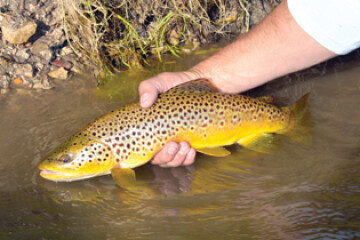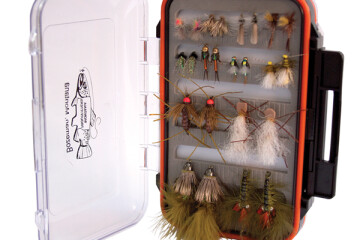So You're Planning a Fishing Trip?
A couple months ago I received a phone call from my buddy James asking if I wanted to go to his bachelor party in April. Obviously, not being one to miss out on a good time I said something along the lines of “Hell yes! What are the dates and where are we staying in Vegas?” James then informed me of his plans to spend the weekend in a wall tent in Southeast Montana fishing for Pike and Bass. I love trout fishing but the excitement of chasing new species and new bodies of water has always excited the heck out of me, so I was even more excited and immediately jumped into research and planning mode.
Anyone who has planned an extended trip to somewhere new knows that there is a ton of work that goes into it. From figuring out where the fish will be, to getting your camping spots dialed, to planning food and drink for the weekend. There are a few resources and tricks I’ve accrued over the years that make this process easier. Here are a few of them to help plan out a successful fishing weekend (even though it doesn’t always work out that way).
First thing’s first, where are you going? If you’re planning your trip around a location, then it’s time to figure out exactly what type of fish you’ll find there, how big they are, and how many of them there will be. If you are planning your trip around targeting a certain species then you need to figure out what bodies of water they’re in. The Fish Wildlife and Parks website has an awesome feature called MFISH. This feature enables you to search by water body, species, and region, and shows annual netting, stocking, and angler’s success rates as well as other information that can be helpful. 
On our bachelor party trip in mid April we knew where we were going and what we were fishing for (Pike and Bass). I used the MFISH system to look at FWP’s specific netting numbers and their location in the lake to figure out where the most Pike and Bass were netted and focused our attention on those areas. Once we knew where the concentrations were we jumped on to my next favorite tool: Google Earth.
Google Earth is a fisherman’s best friend when it comes to exploring new water. With the satellite imaging you can see depth, structure, clarity (always take into account the date of the images), and distance by using their paths tool. I spend hours on this downloadable app before a trip and I will go as far as printing off the images and taking them with me so that we have a constant reference if cell service is bad.
In our case, a lot of the netting was focused on the South end of the lake, with more numbers and most of the big fish coming out of this area. However, after our first morning it was apparent that the inlet had dumped a ton of dirty water into the South end making fishing next to impossible with fly rods. Referencing our notes on the netting and the images from Google Earth we headed up to the north end of the lake where we’d seen a few shallow bays and brushy shorelines with the hope of finding Pike and Bass warming themselves in the shallow water. Temps were still low and we only got into a few Bass the first day and only saw one Pike. Which brings me to my next rather obvious tool: weather forecasts.
While any online weather forecast will probably get the job done, in my experience the most accurate with regards to wind has been the National Oceanic and Atmospheric Association or NOAA.com. Like any trip, checking the weather before you leave is absolutely essential. Changes in weather can turn the fishing off or on and can make for a miserable weekend in the wind and/or rain if you’re camping and spending time on the water.
While we did look at the weather report before we left and saw heavy rain and snow accompanied by dropping temperatures in the area, the trip was already in the books and we were already set to leave. The only upside was that the wind was supposed to be light and the temperatures were supposed to rise over the weekend which we hoped would make the fishing pick up on day two.
Another great tool that every fisherman should utilize whether they’re heading on a trip or just going out for the day is the USGS Water Data site (http://waterdata.usgs.gov/mt/nwis/current?type=flow). If you haven’t checked this website out it’s a phenomenal tool for knowing water flows and temperatures on most rivers in Montana. It allows you to see any major changes in flows so that you don’t drive four hours to find a blown out river that looks more like chocolate milk than clear fishable water.
Lastly, but probably most important to any trip is food; especially if you’re headed to a spot in the middle of nowhere. I like to precook as many meals as possible so that my time is spent fishing, not cooking. Usually I’ll precook breakfast and lunch and have an easy dinner that I can cook over the fire.... (see recipe below)
So back to our weekend of Pike and Bass fishing… With all of this planning and preparation you can definitely up your chances for success on your next trip. The word I’d like to stress here is chances… On our trip we did all of these: scouted Google Earth, checked netting and stocking reports, watched the weather, called some locals for water temps, pre cooked meals, and tied flies for a month straight in anticipation. We landed one Pike and hooked three others that we lost in brush in two full days of fishing. Day two was much more productive than day one as we dialed the lake in and the water started to warm back up. Pike had started spawning and were laying on beds, while the Bass were still sitting in deep water better fished with spin gear. Carp were everywhere but as anyone who has fished Carp knows, when they’re on they’re on and when they’re not, well they just don’t eat.
So in the end you just have to realize that you can’t expect to master a piece of water you’ve never seen before. All you can do is appreciate the experience and excitement of a new landscape and enjoy the company of good friends. Finally, congratulations to James Muhlbeier on his wedding this summer, good luck my friend, I wish a long and happy life with Kaitlyn!
This is a great breakfast recipe for eggs in the morning.
Egg Muffins:
12 Eggs
½ Pound Protein (Breakfast Sausage or Chopped Bacon)
¼ Chopped 4 Cup Chopped Mushrooms
¼ Cup Green Peppers
¼ Cup Chopped Onions
1 ½ Cups Cheese (Your Choice)
Dash of Garlic Salt
Dash of Pepper
Directions:
• Preheat Oven to 350 Degrees
• Cook the protein in a pan with the onions
• Remove protein and add all ingredients to a large bowl
• Using a whisk scramble eggs and mix all ingredients together
• Grease a muffin baking sheet and spoon in 1/3 cups of the egg mixture to each
• Bake 20-25 minutes until an inserted knife comes out clean
I’ll wrap these in saran wrap individually so that we can grab them and go in the morning. There’s a ton of different things to do for lunch (sandwiches are really easy) but I usually like to make something different beforehand such as Pulled BBQ Chicken or Shredded Beef Burritos. You can keep the meat in the cooler and throw it on some bread or a tortilla for a fast lunch.



